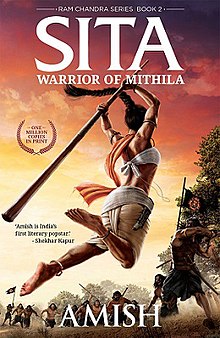 Choosing to
veer away from the traditional and known, Amish Tripathi displays yet another
marvel in his latest book, Sita – Warrior of Mithila. Adapting a lesser known
version of the life of Ram and Sita, i.e. Adbhuta Ramayana, this novel regales
us with the tale of Sita, a princess, a prime minister, a wife and most
importantly, The Seventh Vishnu. The book
follows a multi-linear narration strategy, instead of a mere sequel. The first
book told us the story of Ram. The third will aim at conveying the life
of Raavan. The books following these will continue from the same point where
the first three ended, i.e. Sitaharan.
Choosing to
veer away from the traditional and known, Amish Tripathi displays yet another
marvel in his latest book, Sita – Warrior of Mithila. Adapting a lesser known
version of the life of Ram and Sita, i.e. Adbhuta Ramayana, this novel regales
us with the tale of Sita, a princess, a prime minister, a wife and most
importantly, The Seventh Vishnu. The book
follows a multi-linear narration strategy, instead of a mere sequel. The first
book told us the story of Ram. The third will aim at conveying the life
of Raavan. The books following these will continue from the same point where
the first three ended, i.e. Sitaharan.
Sita is
found as a baby by Queen Sunaina and King Janak, protected by a vulture,
against a pack of wolves. She is adopted by the couple and hailed as the
princess of Mithila. She is sent to Rishi Shvetaketu for tutelage, where she
encounters Maharishi Vishwamitra and his tribe - The Malayaputras. Impressed by
her finesse, pragmatism and knowledge, Vishwamitra selects her as the Seventh
Vishnu. After honing her skills under her new pedagogue - Vishwamitra, she
returns to Mithila, to aid her ailing mother’s rule as the Prime Minister. She
uplifts the country and its citizens and stabilizes its financial
condition.
Then comes
in Ram, a student of Maharishi Vaishishtha. Sita learns of Ram being chosen by
Vaishishtha as the seventh Vishnu and doubts Vishwamitra’s true intentions, in
lieu of the enmity between the Maharishis. She chooses a pragmatic path and
opts for a partnership with Ram, combining the interest of both the Maharishis.
This evolves into a marriage alliance between the pair, arranged by the
scheming Vishwamitra.
However, Raavan
shows up at the swayamwar, where he is enraged by Ram victory. He returns with
an army and lays siege beyond Mithila’s gates. The ensuing battle ends with the
victory of Mithila, but only because Ram used a Daivi Astra – The Asuraastra.
Soon after,
the couple returns to Ayodhya, where Ram seeks a 14-year exile as punishment
for using a Daivi Astra, as per Lord Rudra’s laws. They go into the forest
accompanied by Lakshman as well as the Malayaputras to protect and assist them.
Their exile passes by with various events, ending with the abduction of Sita by
Raavan. Interestingly, there is no golden deer involved, instead Sita is foraging
for banana leaves whilst Ram and Lakshman are off hunting for food, when Sita
is abducted. Also, Lakshmanrekha, renamed as Lakshman’s wall by Amish, is a
defense strategy devised by Lakshman and not a magical barrier drawn by an
arrow.
The book
does not feature Sita as a docile, pretty, little bride, nor as the supporting
character in a patriarchal marriage, whose only role was to be beautiful and dutiful,
accepting every decision of her husband. Rather, she is an adept warrior, with a
muscular lithe structure(as promised on the front cover), ready for combat. Wise and intelligent, caring and stern. she possesses the characteristics of a Vishnu, as needed for the society then, recognized by Vishwamitra. Her abilities and skills impress Ram as well, who expresses an unconventional desire for his wife to lead as the Vishnu and him as her follower.
One cannot
help but await the next book, wondering how Amish will make us sympathize with
Raavan, the man who broke a perfect marriage. Personally, I’m also quite
curious to know how Amish ends up depicting the end of the Ramayana, where,
according to the commonly known mythology, Sita is made to go on an exile by
her husband and ends up asking Mother Earth to swallow her whole to prove her
fidelity in love.
Featuring an
excellent depiction of female Shakti (power) and truly equalizing both the
counterparts in one of history’s most famous marriages, Amish Tripathi works
his magic yet again enticing and entrapping us within these word webs he spins.
No comments:
Post a Comment